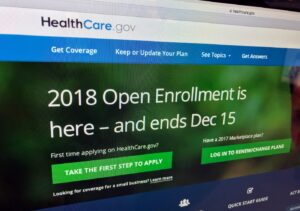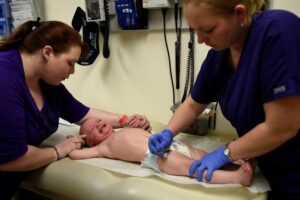The recommended first-line therapy for patients with severe hypertensive acute heart failure (H-AHF) remains intravenous (IV) vasodilators (via bolus) (eg, nitroglycerin) has proved to be safe and effective, with a treatment target of ≤25% reduction in systolic blood pressure (SBP), according to a review published in Current Hypertension Reports. Among individuals presenting to the emergency department (ED) with the H-AHF phenotype, those with increased BP (vs normotensive or hypotensive patients) and rapid symptom onset/worsening – ostensibly representing H-AHF pathophysiology as it is currently understood – appear to derive the greatest benefit from the early administration of vasodilators.
Although there have been plenty of clinical trials examining the use of vasodilators for AHF during the past 20 years, very few have specifically explored patients in whom vasoconstriction is the predominant physiology, where research involved currently recommended medications given at doses that reflect real-world practice.
Additionally, none of the vasodilator trials conducted across 2 decades have demonstrated an impact on mortality, which is, of course, of great interest. Investigators performed a literature review with the aim of answering several key questions regarding early management of H-AHF via BP reduction with vasodilators, in order to provide clinicians with a comprehensive picture of the current understanding of H-AHF pathophysiology and treatment.
Continue Reading
In terms of vascular tone, the AHF population demonstrates considerable heterogeneity that may not be obvious or detectable via physical exam or BP measurement alone. In fact, emerging evidence suggests that despite its frequent use as a criterion for inclusion in vasodilator studies, SBP may not serve as the best hemodynamic surrogate in such cases; rather, in AHF, diastolic BP (DBP) might be more strongly associated with systemic vascular resistance (SVR). However, on this front, the data are rather limited and there is a need for further exploration and corroboration or refutation of such findings.
The H-AHF clinical phenotype comprises 2 major features: SBP ≥140 mmHg and rapid-onset acute cardiogenic pulmonary edema (“flash pulmonary edema”). In contrast to those seen with volume overload, the rapid fluid shifts observed during these episodes are driven mainly by elevated vascular tone and maladaptive splanchnic vasoconstriction, resulting in ventricular-vascular decoupling, which explains why the H-AHF patient subset tends to benefit from vasodilation more than from diuresis.
The presence of these 2 key features strongly suggests H-AHF, but there are several conditions in the differential that may need to be considered, depending on the clinical scenario, prior to making a definitive diagnosis. “In patients with rapid onset pulmonary edema…it is critical to look for a precipitating diagnosis such as coronary ischemia, renal artery stenosis, and acute heart valve pathology such as MVP with acute flail leaflet,” cautions Dennis Finkielstein, MD, the director of cardiology at Lenox Health Greenwich Village and associate chair of the Department of Cardiology at Lenox Hill Hospital in New York City.
Regarding other possibilities, Nicholas Harrison, MD, an emergency medicine physician affiliated with Wayne State University School of Medicine and lead author of the review, adds, “…many important mimics of cardiogenic pulmonary edema which can develop rapidly exist and are important to consider – ARDS, COVID-19, other bilateral pneumonias, to name a few. With that said, in a patient with new and rapid acute onset of pulmonary edema and new acute elevation in BP, there are actually relatively few common clinical entities which mimic H-AHF.”
Prognostically, in a counterintuitive twist, whereas patients with the highest BPs are often evaluated as high risk by ED practitioners, as they commonly appear sickest and present in the most acute distress, these same individuals actually carry the most favorable prognoses. In fact, elevated BP strongly predicts better outcomes among the AHF population seen in the ED.
Despite the fact that SBP may not always function as the best correlate of vascular tone and SVR (and that DBP may serve this purpose more accurately), its use as a determinant of the need for vasodilators during AHF is still heavily ingrained across the research and clinical landscapes (generally as a result of expert consensus vs objective evidence). The assumption – which may not be supported much longer – underlying such utilization is that doing so will select for a vasoconstricted study population.
The few randomized trials that have examined the use of vasodilators in AHF have exposed various limitations of the evidence found, including the possible mismatch between SBP and SVR. Other important limitations observed across multiple studies involved heterogeneous treatment effects according to BP measurement (often underreported), issues with the timing of enrollment and outcome assessment (often measured at ≥180 days post-index admission) where delays by way of protracted follow-up can dilute therapeutic impact, ineffective testing of the hypothetical end-organ protective impact of vasodilators, and the questionable use of mortality as a primary endpoint in certain cases (especially considering that higher BP often predicts reduced mortality in patients with AHF).
Before examining the various classes of vasodilators currently available to ED physicians and cardiologists for the treatment of H-AHF, it is worth noting that there are some potential harms associated with their use. Most important and common among them is hypotension; however, in severely hypertensive patients with AHF, even aggressive therapy rarely results in this complication.
Acute kidney injury (AKI) is another frequent concern because of hypothesized reduced renal blood flow, but it is now largely accepted that AKI and chronic renal disease result from increased renal afterload (secondary to central venous congestion) rather than decreased renal preload from hypotensive renal arteries. And morphine, specifically, should be avoided in most patients with AHF, because of an increased chance of in-hospital death associated with its use.
By and large though, most commonly used vasodilators have proved to be safe, effective, and well tolerated in the AHF population. One caveat is that caution should be exercised when using vasodilators during the treatment of normotensive patients with AHF.
The first class of medications considered was angiotensin-converting enzyme (ACE) inhibitors, with a specific focus on enalaprilat, which has demonstrated good arterial and splanchnic vasodilation, among other physiological benefits, in the few studies examining its use in H-AHF. This ACE agent offers rapid and sizeable BP reduction with a generally benign safety profile, but more research is needed regarding significant outcomes in H-AHF. Other ACE inhibitors or angiotensin receptor blockers commonly prescribed for chronic HF do not have enough evidence to support their use in AHF.
Natriuretic peptide vasodilators initially showed some promise for use in AHF, but after disappointing findings across multiple trials of nesiritide and ularitide, the reviewers found there was not enough evidence to support their use in treating H-AHF. This was largely due to mostly equivocal results regarding impacts on mortality. Likewise, although serelaxin (a relaxin peptide synthetic analogue) at first appeared promising in terms of a mortality benefit, researchers failed to replicate this finding in subsequent studies.
With nitric oxide metabolism directly implicated in pathophysiological AHF ventricular-vascular decoupling, nitrates, with their extensive proven track record as a mainstay vasodilator, continue to be the optimal choice for most patients presenting with H-AHF, especially when given soon after diagnosis.
Although oral nitrates are not useful in this scenario because of their slow and variable absorption, sublingual (SL) nitroglycerin offers nearly complete bioavailability and rapid absorption, and IV infusion of nitrates results in rapid splanchnic and arterial vasodilation. However, most studies involving IV infusion have used doses far lower than those used clinically in the ED. And nitrates are somewhat limited by their tendency to achieve tachyphylaxis when given via infusion.
To get around this limitation, nitroglycerin can be given as a bolus injection (via IV push) –
generally, 1-2 mg every 3-5 minutes until the target BP is reached and symptoms have subsided. Phillip D. Levy, MD, an emergency medicine physician and professor at Wayne State School of Medicine and another author of the review, states that “…a reasonable approach based on synthesis of research from different timepoints in the typical H-AHF ED and hospital course is to utilize bolus high-dose vasodilators like nitroglycerin in the very early stages (within minutes to a couple of hours from ED arrival) while aiming to transition the patient to the appropriate guideline-based medical therapies as soon as clinically-feasible.”
In the event that IV access is not possible, SL nitroglycerin can be used alternatively and offers a pharmacokinetic profile similar to that seen with a bolus (though doses are restricted to 0.4 mg per tablet). And though no controlled study to date has shown a mortality benefit for nitroglycerin, there is a serious question of whether it is an appropriate endpoint, given the low baseline mortality of the H-AHF population. The authors asserted, “Randomized blinded trial data on high-dose bolus nitroglycerin are lacking, but strongly needed given the apparent benefit noted in non-RCTs.”
Other antihypertensive vasodilators were also briefly considered, including tezosentan and cinaquigat, which both produced negative results. Clevidipine showed promising results with good effects on dyspnea that warrants further investigation and urapadil, reportedly used in Asia successfully, appears to offer hemodynamic benefits and an excellent safety profile. Hydralazine, which is frequently used to control hypertension in other clinical scenarios, is less suited for use in H-AHF, because it selectively leaves the splanchnic circulation virtually undilated and therefore has minimal impact on the vasoconstriction occurring there and driving H-AHF. As for β-blockers and other nonvasodilator agents, there is no indication for their use in H-AHF for acute BP reduction.
In terms of targeted BP reduction, lowering SBP by ≤25% is recommended, with more recent evidence supporting this target via a reduction in mortality, thus adding to the expert consensus largely driving its use heretofore. Still, the debate over which measure best reflects actual SVR continues, and the landscape may soon be shifting. “I would say that our work, as well as the physiologic rationale supporting DBP as a better surrogate of SVR, would suggest that we should consider DBP-targets in future protocols,” agreed both Harrison and Levy.
“Bolus dosing of nitroglycerin, despite lacking RCT evidence, is a good option given a strong safety record, and potential improvement of important outcomes when used in the most clinically severe hypertensive AHF patients,” concluded the authors. Still, Harrison and Levy readily conceded, with a hopeful nod toward the future, “From a research standpoint, this a place where we have a lot of room to improve. However, it is our hope to begin an RCT with H-AHF patients in the very earliest minutes of ED presentation in the near future.”
Disclosure: Several study authors declared affiliations with the pharmaceutical industry. Please see the original reference for a full list of authors’ disclosures.
Reference
Harrison N, Pang P, Collins S, Levy P. Blood pressure reduction in hypertensive acute heart failure. Curr Hypertens Rep. 2021;23(2):11. doi:10.1007/s11906-021-01127-8
This article originally appeared on The Cardiology Advisor





